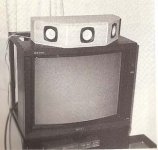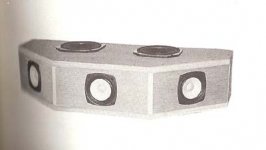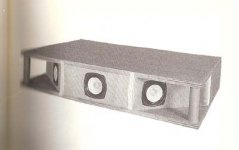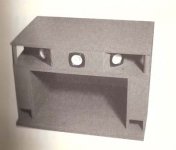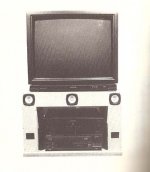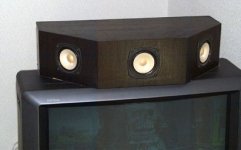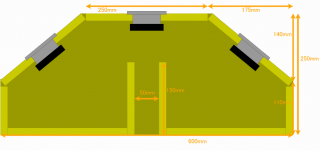In the simulations of a hard left pan, Elias shows that you can get some pretty clean separation - about 10 to 15 dB it looks like I I am reading the contour of correctly.
An externally hosted image should be here but it was not working when we last tested it.
This is actually the measured directivity plot of the single speaker stereo with left panned stereo signal. Left side is at -90 degrees, and right side at +90 degrees. Important is see the levels at 45 degree angles, because that's where the room side wall reflections come to the listening position. With the matrix one gets the best separation around exactly at +-45 angles.
How is this possible is because the matrix not only sums the signals but also differentiates, so it forms a vector steering of the sound field.
At 10kHz one can see the full range element beaming and directivity collapses. It may be beneficial to slightly tilt the side panels forward like Nagaoka has done in his speakers.
.
It's not for critical listening but for some applications like an mp3 kitchen speaker or clock radio
Come on, this is not a competition of who builds the worst sounding speaker with the crappiest and cheapest materials and components 🙁
Choose good quality parts, elements, amplifiers, box materials, and get the good sound
 🙂
🙂.
It may be beneficial to slightly tilt the side panels forward like Nagaoka has done in his speakers.
I was looking at exactly this with my setup. With true independent speaker boxes to represent each side driver I was playing around with angling the side speakers to see where the best imaging would occur. So far, it is not conclusive yet. Wouldn't angling the sides forward force the sweet spot to be farther away? So it may depend on the room and where one wants the sweet spot to be? Once I figure out where the best spot is I can build the single enclosure in that geometry. Do you have any good tracks/recordings that you use to test spatial imaging and soundstage? A link to a YouTube video would be all that is needed. I have some tracks from nicely recorded stereo mic setups from a small jazz club that I use (just a stereo mic at one position).
Come on, this is not a competition of who builds the worst sounding speaker with the crappiest and cheapest materials and components 🙁
Choose good quality parts, elements, amplifiers, box materials, and get the good sound🙂
.
I am not saying to build the cheapest speaker - but I think as an experiment to get folks to try it and experience the sound for themselves, a low cost test case or experiment with good sounding but cost-effective components is in order. Although I use a $12 Vifa TC9FD, I do believe it is one of the best sounding full range drivers at any price. You don't need to spend $100 on a full range driver to get 90% of the benefits. Similarly, the use of a $5 TDA7297 is another great sounding amp that allows matrixed connections needed to play with this compared to class D amps. If it sounds good on a $5 TDA7297, it will sound even better on an LM3886, etc. or true class-A amp. But for cost of a little over $40 someone can build a very nice sounding single-box stereo speaker that would indeed sound pretty much better than any single box mp3 player you can buy in the $200 price range.
Maybe I have not reached an optimal setting but I am not able to get the soundstage to be super wide yet.
Last edited:
I was looking at exactly this with my setup. With true independent speaker boxes to represent each side driver I was playing around with angling the side speakers to see where the best imaging would occur. So far, it is not conclusive yet.
I don't think separate boxes can do the vectors correctly.
First, there must be the correct physical distance between the drivers in the critical midrange frequencies. Using separate boxes results too long distances.
Secondy, box difraction must be orderly correct for right kind of vectors to be formed. With multible boxes there will be unknown difraction which bends the wavefront in wrong direction.
It is actually a very delicate system, this single stereo loudspeaker !
The magnifigance is hidden behind the seeming simplicity. Don't get fooled 🙂
.
Maybe I have not reached an optimal setting but I am not able to get the soundstage to be super wide yet.
After you have corrected the box issues, then ...
Also, the listening distance should not be too close to the speaker.
.
I don't think separate boxes can do the vectors correctly.
First, there must be the correct physical distance between the drivers in the critical midrange frequencies. Using separate boxes results too long distances.
Secondy, box difraction must be orderly correct for right kind of vectors to be formed. With multible boxes there will be unknown difraction which bends the wavefront in wrong direction.
It is actually a very delicate system, this single stereo loudspeaker !
The magnifigance is hidden behind the seeming simplicity. Don't get fooled 🙂
.
I am looking forward to an improvement in the sound once I put it in a single box. The spacing is currently 16 in wide side to side, is that too wide? Also, could not a test "box" be implemented in a U shaped open baffle tri-fold of stiff cardboard or foam core so that the angle of tilt can be adjusted? Or will the semi dipole behavior of the open back ruin everything?
When you say the spacing and arrangement is delicate what is the max spacing between left and right channels?
What would be a fitting solution for a helper woofer under such a Matrix speaker? Monopole? Dipole? Running a summed mono signal, or differential signal (probably not a great idea on that last one....)?
Is it better to keep the Matrix speaker a certain distance from the back wall?
Is it better to keep the Matrix speaker a certain distance from the back wall?
In 1980's when VHS video cassette ruled the world, there was a need to focus on audio quality on audio-video systems.
Then Tetsuo Nagaoka designed these matrixed single stereo speakers.
Nagaoka MX-16AV
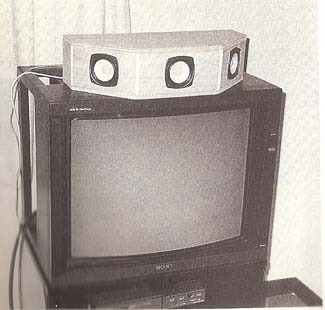
Nagaoka MX-17AV
with extra bass output
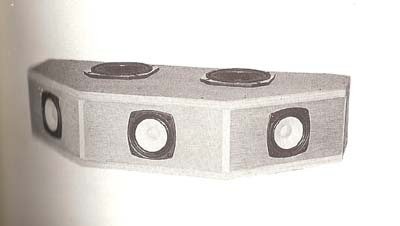
Nagaoka MX-20AV
to be placed under the TV
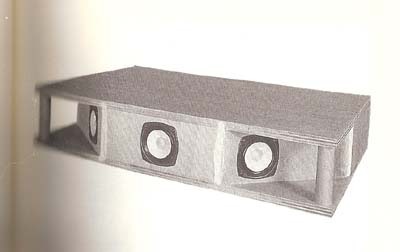
Nagaoka MX-200AV
complete AV rack. Reflex ports on the bottom ?
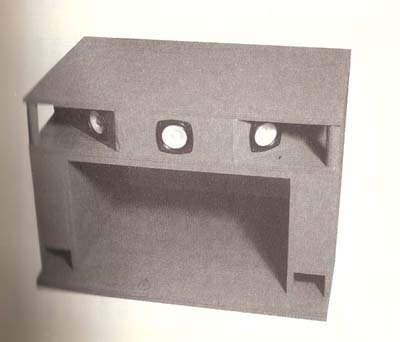
Nagaoka MX-210AV
with elements directed at front
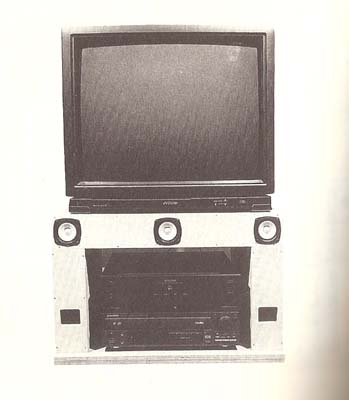
from here:
http://yosigaki.s214.xrea.com/nikki20090401.html
Then Tetsuo Nagaoka designed these matrixed single stereo speakers.
Nagaoka MX-16AV

Nagaoka MX-17AV
with extra bass output

Nagaoka MX-20AV
to be placed under the TV

Nagaoka MX-200AV
complete AV rack. Reflex ports on the bottom ?

Nagaoka MX-210AV
with elements directed at front

from here:
http://yosigaki.s214.xrea.com/nikki20090401.html
Attachments
Nagaoka MX-16AV
‚»‚Ì‘¼‚̃VƒXƒeƒ€‚»‚Ì‚R
And plans
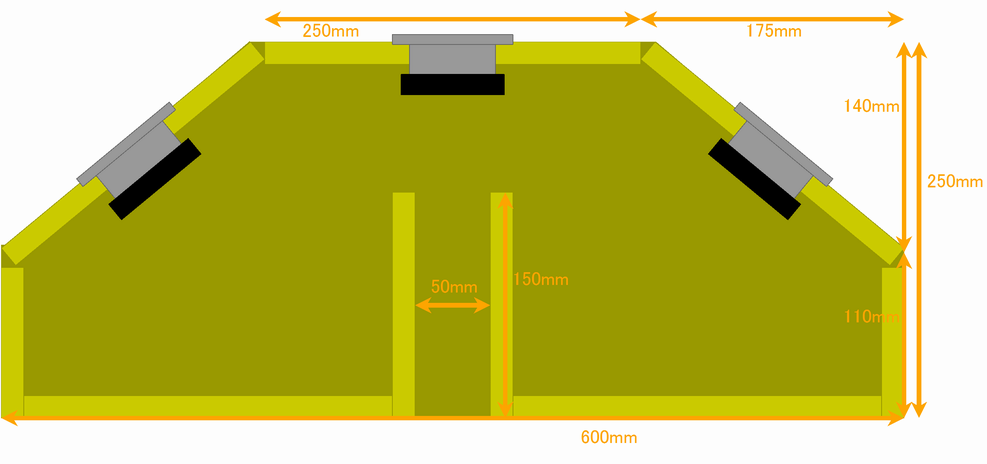
?????
.
An externally hosted image should be here but it was not working when we last tested it.
‚»‚Ì‘¼‚̃VƒXƒeƒ€‚»‚Ì‚R
And plans

?????
.
Attachments
I am looking forward to an improvement in the sound once I put it in a single box. The spacing is currently 16 in wide side to side, is that too wide? Also, could not a test "box" be implemented in a U shaped open baffle tri-fold of stiff cardboard or foam core so that the angle of tilt can be adjusted? Or will the semi dipole behavior of the open back ruin everything?
When you say the spacing and arrangement is delicate what is the max spacing between left and right channels?
I don't think OB will work for this matrix. Closed box is better, and elements can share the same volume.
Because I discovered this single speaker stereo system independently, I used dimensions slightly smaller than Nagaoka, plus I used 90 degree angles in the box. I tested box widths between about 20 and 25 cm. The size of the side panel should be big enough, I would say minimum of 30*30 cm.
.
What would be a fitting solution for a helper woofer under such a Matrix speaker? Monopole? Dipole? Running a summed mono signal, or differential signal (probably not a great idea on that last one....)?
Is it better to keep the Matrix speaker a certain distance from the back wall?
If the cross over if low enough, the topology of the added bass may not be critical.
Most elegant is to use matrix bass, of course 😉
And the vicinity of the front wall seems not to be critical. I've pushed the box touching the front wall without much influence. Except of course there is some bass boost with on the wall placement.
.
Nagaoka MX-16AV
An externally hosted image should be here but it was not working when we last tested it.
‚»‚Ì‘¼‚̃VƒXƒeƒ€‚»‚Ì‚R
And plans

?????
.
What is the height dimension?
nice looking, but...................
Most tv's over here are 3" thick.
Maybe if the tv sat on the speaker. I like it though.
Maybe run a 30 degree angle off the front for the stereo speakers, then break another 30 degrees to run the surround channel. Too bad surround is in stereo. The dipole surround was my favorite for fooling you into believing you are in the space. But with the dipole surround, as soon as a single bullet travels from front left to back right, it sounded like it went into a cave.
Norman
Most tv's over here are 3" thick.
Maybe if the tv sat on the speaker. I like it though.
Maybe run a 30 degree angle off the front for the stereo speakers, then break another 30 degrees to run the surround channel. Too bad surround is in stereo. The dipole surround was my favorite for fooling you into believing you are in the space. But with the dipole surround, as soon as a single bullet travels from front left to back right, it sounded like it went into a cave.
Norman
Nagaoka MX-10
There was an improved version of MX-1 called MX-10, with more bass output apparently using some sort of reflex port extension hidden in the base.
The 4 element matrix was the same as in MX-1.
An externally hosted image should be here but it was not working when we last tested it.
An externally hosted image should be here but it was not working when we last tested it.
from here:
.page besides SPI sound plaza Ida / handmade speaker basic lecture (6)/wonderful speaker.page
An externally hosted image should be here but it was not working when we last tested it.
from here:
�ì•i�W2

from here:
FE103-Sol???????? | Phile-web??????
.
This MX-10 DBR looks quite interesting, as you'd need a stand anyway. And, instead of a matrix connection it would be fun to try a classic series/parallel connection to use it as a speaker for one channel with wide dispersion (I'd put the front firing ones next to each other then). Or, with a multipole switch it should be possible to use it as both a single matrix speaker, or as one half from a stereo pair.
But from the drawing above, it is not obvious what the dimensions are of the ports (a) between top and base, and (b) between base and the outside world.
Living now in hong kong in an apartment, it is difficult to diy nowadays but this design simply looks cool.
Nagaoka's R-101 Hidori is also said to work with Matrix cabling. It looks like an alien sculpture...
From: .page besides SPI sound plaza Ida / handmade speaker basic lecture (6)/wonderful speaker.page
Given more free time and place, these would be fun things to try.
An externally hosted image should be here but it was not working when we last tested it.
An externally hosted image should be here but it was not working when we last tested it.
From: .page besides SPI sound plaza Ida / handmade speaker basic lecture (6)/wonderful speaker.page
Given more free time and place, these would be fun things to try.
- Home
- Loudspeakers
- Full Range
- Master Nagaoka Tetsuo explorations on matrixed single stereo speakers
